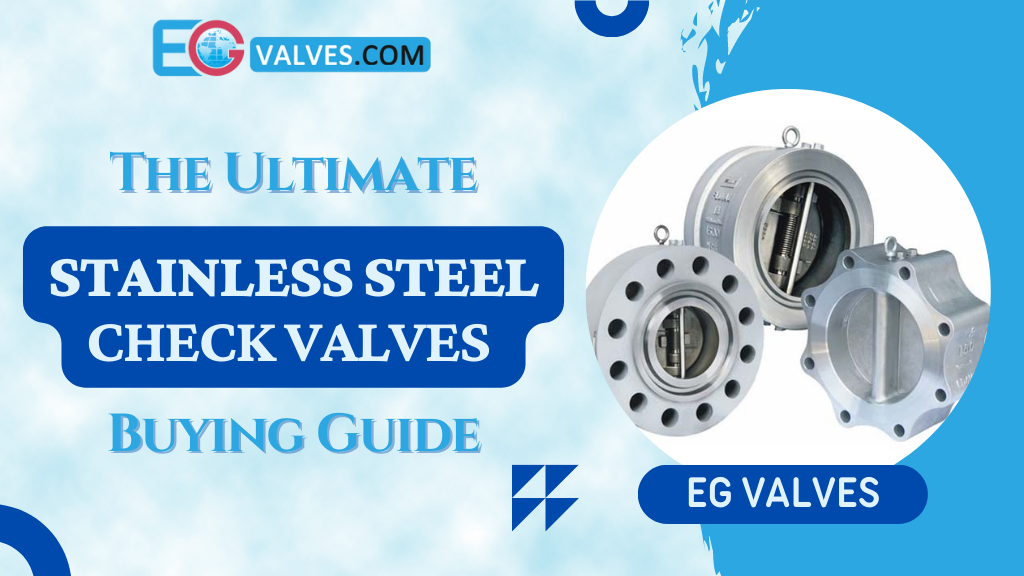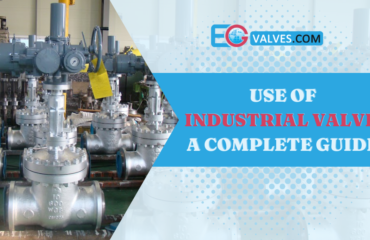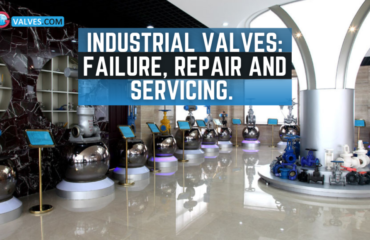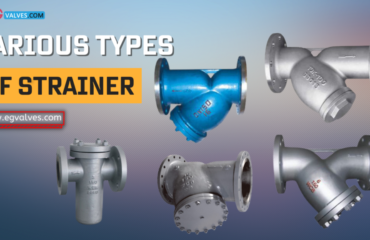Stainless steel check valves are an essential component of any industrial or commercial plumbing system. They are designed to control the flow of liquids and gases in a variety of applications and are available in a variety of sizes and types.
If you’re in the market for a stainless steel check valve, then this is the ultimate guide for you. Here you’ll find all the information you need to make an informed purchase. From the different types of valves available to the advantages and disadvantages of each, you’ll learn about the type of materials used in stainless steel check valve manufacturing, as well as the different features and benefits they offer. With this knowledge, you’ll be able to choose the perfect check valve for your application. So let’s get started and explore the world of stainless steel check valves.
Types of Stainless Steel Check Valves
There are four main types of stainless steel check valves available:
- Swing check valves,
- Plug check valves,
- Ball check valves,
- and Inverted swing check valves.
Each of these types has its own unique features and benefits, which we’ll go into detail about later in this guide. They can be used in a variety of applications including cooling systems, liquids, gases, and water systems.
Swing check valves are designed to allow fluid to flow in one direction, either in or out. They are installed at the end of a pipe or line. This is the most popular type of check valve.
Plug check valves are designed to flow from one direction, but only in the direction of the pressure. They are used for the one-way flow of liquids, gases, or steam.
Ball Valve China is another type of simple and cost-effective one-way valve. They are used in a system with a liquid that may contain solids. They are mounted on a seat that is held in place by a ball.
Inverted-Swing check valves are the same as Swing check valves, but they are mounted on the opposite end of the pipe. This is useful in applications where there is a change in direction of the flow.
Advantages of Stainless Steel Check Valves
Stainless steel check valves are designed to be long-lasting, durable, and reliable. They are built to withstand high pressure and flow rates, making them ideal for a variety of applications. They are corrosion-resistant, which means they can withstand exposure to a wide range of liquids without rusting or corroding. This makes them ideal for use in wastewater treatment plants, oil and gas refineries, chemical plants, and many other industrial applications.
Stainless steel check valves are economical to maintain and repair. They can be used in a wide range of temperatures, which means they can be used in applications where other valves would be damaged by extreme temperatures. This industrial valve is also resistant to chemicals, which makes it ideal for use in wastewater treatment plants, where it comes in contact with a wide variety of chemicals.
Disadvantages of Stainless Steel Check Valves
While stainless steel check valves are durable and reliable, they are not the fastest or easiest valves to replace. Due to their design and construction, it can be challenging to get to the internal parts when a repair is needed. It may require removing the valve from the application. This can be time-consuming and costly, as well as disruptive to the overall operation of the system.
Another potential disadvantage of stainless steel check valves is that they can be too restrictive at times. This can lead to a system pressure drop, which can cause a variety of problems. In some situations, this can cause the application to fail, which is obviously a serious issue.
Materials Used in the Manufacture of Stainless Steel Check Valves
When purchasing a stainless steel check valve, it’s important to know the materials used to manufacture it. This will give you insight into the valve’s strength, durability, and reliability.
Valve Manufacturers generally use three different types of material to produce stainless steel check valves:
- Carbon Steel
- Stainless Steel
- Nickel Alloys
Carbon steel check valves are inexpensive, but they are not very strong or durable. It is recommended that you avoid this type of check valve.
Stainless steel and nickel alloys are the most common materials used in the manufacture of check valves. Stainless steel check valves are corrosion-resistant and strong. They are ideal for use in a wide range of industries and applications.
Nickel alloys are high-strength, corrosion-resistant, and extremely durable. They are an excellent choice for use in critical applications. They are expensive, but they provide long-term durability without maintenance.
Features and Benefits of Stainless Steel Check Valves
There are many features and benefits to be found in a stainless steel check valve. These include-
- Stainless steel construction: They are corrosion-resistant and built to last a long time.
- Wide temperature range: Stainless steel check valves can be used in a wide range of temperatures.
- Variety of materials: There are many different materials used in the manufacture of stainless steel check valves. The presence of Molybdenum in SS316 makes it even more resistant to corrosion.
- Easy installation: Easy to install and designed for quick and easy operation.
- Low maintenance: These valves do not require frequent maintenance.
- Reliable operation: These valves provide long-term durability without maintenance.
- Economical: Economical to maintain and repair compared to zero-lead brass.
- Variety of sizes: Available in a variety of sizes and can be used in many different applications.
Stainless Steel Check Valves – Additional Benefits
Apart from the general benefits that you savor, here is a look at some additional advantages you have with SS check valves over others:
Higher Corrosion Resistance
Stainless steel as a valve material can resist corrosion way better than other materials. This is a significant advantage, especially when you know you are going to be dealing with corrosive substances. Moreover, since valves are supposed to open and close frequently, corrosion can be a big issue. Rust and corrosion over time can cause valve failure. And using stainless steel check valves can help you use it across varied working environments.
Valves made out of stainless steel type SS304 and SS316 are easily available in the market. While the former would prove a good pick for short-term use, you can always rely on SS316 for more corrosion-resistant valve material.
Higher Pressure Rating
Stainless Steel Check Valves including those from valve manufacturers like EG Ball Valve China have a higher pressure rating as compared to brass valves. Where standard brass valves can withstand up to 600psi on a 1” model, stainless steel valves can effectively resist up to 1000psi on a similar model. If you are looking for an industrial valve, having a SS check valve that can withstand high pressures should likely be your number one choice.
Broad Range of Applications
One of the key advantages of using Stainless Steel check valves is that they can be used in a broad range of applications. With its superior qualities, it is a preferred valve type and is used in a majority of plumbing applications in addition to commercial and industrial scale use as well.
Choosing the Right Stainless Steel Check Valve for Your Application
When purchasing a stainless steel check valve, it’s important to match the valve with the application. The application will determine the type of industrial valve needed. In some situations, more than one type of valve may be needed. Let’s take a look at some factors you should consider when choosing a stainless steel check valve for your application:
Flow Rate
The flow rate is how much fluid is flowing through your system. It is important to match the flow rate with the correct valve. If the check valve that you use closes rapidly, it may prevent slamming but not surges due to pumps starting and stopping. Rapid opening and closure will bring a sudden change in the flow, thereby causing surges that might risk system failure.
Valve size and design
You’ll also need to consider the size and design of the valve. The size of the valve will determine how much flow it can handle. The design of the valve will determine how much pressure it can withstand. Therefore, selecting an industrial valve that meets your requirements accurately is important.
System Pressure
You’ll also need to take the system pressure into consideration. The pressure in the system will determine if a ball or swing check valve is needed. The higher the pressure, the more likely you’ll need a swing check valve.
Fluid Type
The type of fluid flowing through the system will also determine which type of valve is needed. Certain liquids and gases require different valve types. Different check valves are required for different applications. Although all of them can handle water and treated wastewater, handling raw wastewater can cause issues. Therefore, considering if the presence of solids in the fluid affects the valve operation is important too.
Installation
You’ll also need to consider how the valve will be installed. Swing and plug check valves can be installed horizontally, while ball check valves must be installed vertically. Therefore, before you start looking for ball valve China, consider studying your industrial design and ways you can make it more efficient.
Other Components
There may be other components in the system that you’ll need to consider. You’ll need to make sure the valve is compatible with all other system components and works perfectly when combined. If a single one of it mismatches, you might risk system failure.
Ownership Costs
The cost of an industrial valve is more than just its retail price. Where the actual costs may be limited to purchasing and installation in some cases, they might also include maintenance and energy in others. Therefore, when you consider buying check valve China for your specific application, it’s better to have an idea about the lifetime operational costs. The simple the valve that you use, the lower will be the maintenance requirements. Swing check valves and Ball check valves are some cost-effective options you can buy.
Working Characteristics
Since different stainless steel check valves have different working characteristics, identifying the correct type becomes important.
Vertical lift-type valves are best for horizontal pipe installations with a 50mm diameter. You can install a straight-through type valve for both horizontal and vertical pipes, but a bottom valve is preferred for the inlet pipe.
Lift-type rotary check valves generally offer good sealing performance and higher fluid resistance. However, a horizontal and a vertical valve is required on the horizontal and vertical pipes respectively. When it comes to Swing check valves, you can select any installation position from horizontal to vertical and inclined.
Similarly, when it comes to butterfly check valves, the installation position can again be horizontal, vertical, or inclined, depending on your specific requirements. Another form of the diaphragm check valve is used when water hammering occurs due to the reverse flow of the medium. Therefore, it is prudent to use it in low temperature and pressure conditions. Finally, ball valve China is apt for low to medium pressure conditions.
Get Quality Stainless Steel Check Valves from EG Valves
EG Valves is among the leading industrial valve manufacturers in China, with an extensive range of products to suit varied project requirements. From Gate Valves to Globe Valves, Ball Valves, Butterfly Valves, Y Strainers, and Check Valves, we have everything to cater to your next application.
With 19 years of experience in manufacturing, we can provide you with industrial valves that are second to none. Our products conform to the latest ANSI, API, DIN, and JIS level industry standards that ensure you get complete value on your investment. Our quality check team ensures that only high-quality raw material is used and precise machining is done to come up with a product that is top-notch.
If you have a requirement for industrial valves, you can browse through our collection of quality stainless steel check valves, now!




